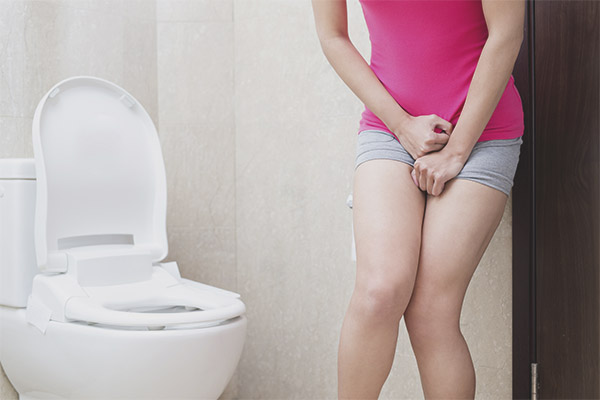The content of the article
After a complicated labor process, the pelvic floor muscles lose their elasticity, and urinary incontinence may occur in the young woman. Involuntary biofluid leakage is also characteristic of menopause, when an aging female body undergoes a series of changes. With a weak pelvic muscle apparatus, urinary incontinence occurs when coughing, sneezing, and exertion. The deterioration of the urethra tone only exacerbates the problem - the ligaments of the urethra stretch even more, provoking the further development of incontinence.
Disease classification
Doctors share urinary incontinence by signs. Classify:
- Stress incontinence due to increased intra-abdominal pressure.
- Urgent incontinence, in which involuntarily very strong urges involuntarily urinate.
Stress, as practice shows, often becomes the main cause of involuntary emission of urine, even with a slight filling of the bladder. The symptom of urinary incontinence is a sudden, sharp urge to emit, after which an involuntary leakage from the urethra occurs. Today, this type of disease is most common among people. Urine can also be released from the urethra after an increase in abdominal pressure (for example, sneezing and coughing).
Urgent incontinence appears when instability of the urinary sphincter, neurogenic bladder dysfunction, pathology of the motility of the urinary organ, and weakness of the pelvic floor muscles are present. As a result of various deviations, the integrity of the neuromuscular structure of the urethra and bladder is disrupted. Urgent urination is characterized by hyperactivity of the bladder walls and contraction of the muscle walls during its filling.
Overstrain of the ligament apparatus of the urethra after a severe, traumatic delivery is a major factor in the development of urinary incontinence in women.
In some women, incontinence is an essential sign of aging. The disease is very common among the female population of the planet. Changes in the organic structures of the urogenital system develop with age. If a woman gives birth, her ligaments of the vaginal muscles, urethra and pelvic floor eventually lose elasticity.
On a severity scale, urinary incontinence is classified as a mild, moderate or severe disease. Symptoms of the disease occur due to a violation of the anatomical ratio of the female pelvic organs. Under stress incontinence, the proximal urethra shifts. Against the background of changes in the organic structures of the urethra, the front walls of the vagina are drooping. As a result, the sphincter loses its contractility, and the muscle fibers of the apparatus are destroyed.
Causes of development
The disease is associated with the dislocation and weakening of the urethra and its ligaments. To keep the urine in place, a certain urethral pressure is needed. When it is violated, an involuntary leakage of biological fluid develops.The indicators of urethral pressure from positive become negative. Under the influence of constant physical exertion and menopause disease progresses.
The main causes of the disease are:
- difficult childbirth;
- surgical intervention in the pelvic structures;
- exposure to radiation;
- neurological ailments;
- abnormalities and pathologies.
Such factors as overweight, taking certain medications, disorders of the gastrointestinal tract, menopause, infection of the urinary tract can contribute to the progress of the disease. When collecting the history of the disease, the doctor pays attention to such features as the presence of hard physical work, varicose veins, somatic and anatomical pathologies.
Often, urinary incontinence in women is manifested by undermining and leakage. This is due to the weakness of the sphincter and ligament apparatus of the urethra. Various disorders in the ureter, vagina, urethra can affect the development of the disease.
To fix the problem, you need to seek help from an urologist-andrologist. For a complete diagnosis of the disease, the doctor after taking anamnesis prescribes urodynamic examination, cystometry and electromyography.Appropriate tests, ultrasound of the bladder, vaginal and cervical examination are performed.
Drug therapy
For the treatment of stress urinary incontinence prescribed funds that increase the tone of muscle structures. Adrenergic drugs strengthen the muscles of the pelvic floor and eliminate their weakness. Medication is advisable for bladder hyperactivity. Also in the complex therapy, estrogens and antidepressants are used, which increase muscle contraction.
Medicines have a beneficial effect on the bladder tissue and increase the tone of the pelvic floor. Usually, women are given the drug Driptan, but the choice of the drug to correct the problem depends on the characteristics of the disease and its severity. Under the influence of the prescribed drug, the structures of the bladder are relaxed, the urge to urinate is eliminated, the number of visits to the bathroom is reduced.
Driptan has a powerful antispasmodic and myotropic effects. It completely relaxes the detrusor, namely this muscle is responsible for the contraction of the bladder.As a result of drug therapy, the capacity of the bladder cavity increases, the number of contractions of the pelvic floor muscles decreases, sphincter function stabilizes. It is possible to judge the results of the therapy only after 1.5 months of continuous medication.
In some cases, it is possible to prescribe such drugs as Trospium Chloride, Tolterodin, Oxybutin. These drugs eliminate bladder hyperactivity. The treatment regimen requires proper dose selection. The drug Oxybutynin has an anesthetic effect and has an antispasmodic effect. Usually, this drug is prescribed 2.5 to 4 mg twice a day. If a urinary tract infection is present, antibiotics are taken.
In order for the treatment to give a positive result, it needs to be combined with performing intimate gymnastics. Kegel exercises and weights help to eliminate the weakness of the vaginal muscles and urethra. Such therapy is designed specifically to stimulate the pelvic floor muscles.
Set of exercises
To strengthen the muscles of the perineum, Kegel exercises should be combined with the well-known gymnastic complex.It is useful to perform such positions as "birch", "scissors", "bicycle". Also during the day you should wear a small ball between your legs, holding it high enough.
Women with urinary incontinence are required to perform intimate kegel exercises daily. This set of exercises was developed specifically to eliminate incontinence symptoms. Daily training of the pelvic floor muscles will help to avoid surgery and improve the tone of the ligamentous apparatus of the urethra.
The complex includes such exercises for the structures of the urethra:
- squeeze the vaginal muscles and lift them up, hold in this position, counting to 10;
- completely relax the vagina and pelvic floor muscles, count to 10;
- repeat the tension and lift muscles, and after relaxation.
The alternation of exercises helps to increase the elasticity and tone of the apparatus of the urethra. The complex can be used during pregnancy and during menopause, for the prevention and elimination of urinary incontinence and feces.
Intimate gymnastics includes various squeezing and tension of the vaginal muscles. It has a very positive effect on the state of the urethra. To improve the tone of the pelvic floor apparatus, you can also use the following exercise:
- insert the index finger into the vaginal cavity;
- squeeze your finger tightly and hold the pressure for about 10 seconds.
It is useful to perform rapid contractions and contractions of the vagina. Squeezing and unclenching of the vaginal walls is carried out at least 10 times. Gradually, you can increase the time of compression and relaxation, as well as the number of approaches.
Holding weight
A good way to overcome urinary incontinence is to hold weights with vaginal muscles. To improve the tone of the muscular system of the urethra and vagina take loads weighing up to 50 grams. The weight should be placed in the cavity of the vagina and walk with him around the house, doing the usual things. It takes about 3-4 times a day to carry the weight inside the vagina.
At the very beginning of such therapy, it is necessary to use loads with a minimum weight, then the weight of the products is increased. Exercise helps to strengthen the muscles of the pelvic floor and stop the involuntary leakage of fluid from the urethra.
Surgical care
With stress and urgent forms of incontinence, an operation is indicated. The decision to conduct the operation should be after drug therapy has not helped.If medication treatment has not had a proper result for 3 months, then the doctor may prescribe an operation. There are a large number of different surgical techniques to eliminate urinary incontinence. Some of them are minimally invasive and quite effective.
Before the operation, the woman should undergo a full examination and prepare for surgery. The age of the patient, the features of her body, the presence of chronic diseases are taken into account. The operation allows:
- eliminate the symptoms of urgency;
- restore normal urine emission;
- eliminate the anatomical displacement of the urethra and pelvic organs.
In modern medicine, the use of artificial grafts - Prolene loops has been widely developed. Such surgical intervention is the main method of solving the problem. During the operation, the surgeon uses a curved needle, a loop is inserted under the urethra, which provides support for the canal. The doctor fixes the loop in the desired position and checks its adhesion with the surrounding tissues. Next, the loop is displayed on the abdominal front wall. In another method, a loop is led through the groin area.
A three-dimensional image of the desired cavity on the screen helps to avoid errors during surgery. The doctor competently eliminates prolapse of the genitals and urethra, eliminates sphincter insufficiency and corrects the anatomical location of the urethra.
The prolen product is not rejected by the female body and serves long enough to support the urethra. Gradually, the loop is covered with tissue, which forms an additional basis for the urethra. The operation is simple and does not require a long stay of the patient in the hospital. It does not leave scars and unpleasant traces.
After surgery, strong physical and sports activities are contraindicated for the woman. Also need to refrain for a couple of months from sexual activity. A significant positive effect will give full compliance with medical prescriptions. In the recovery period, a specific drug therapy may be prescribed.
Physiotherapy
Well help to strengthen the muscles of the pelvic floor physiotherapy. Apparatus treatment helps stimulate the detrusor of the bladder. In the treatment of the disease are used:
- electrophoresis using antispasmodics;
- paraffin therapy;
- exposure to ultrasound;
- UV irradiation of the required areas;
- myostimulation of muscle structures;
- SMT therapy;
- galvanic effects.
At electrophoresis, solutions of atropine, aminophylline, platifillin are used. The current density is regulated by the apparatus. At least 12 procedures are assigned to fix the problem. After completing the full course in 20% of women, there is a cessation of urine leakage during the day.
Good help to cope with the disease application with paraffin. They have an antispasmodic effect on the necessary zones and relaxes the smooth muscles of the bladder. In the treatment using paraffin, heated to 45 degrees. The application must be kept for about 40 minutes. A course of paraffin therapy - at least 10 procedures.
Ultrasound treatment is a way to permanently get rid of the disease without surgery. Under the influence of ultrasonic waves improves blood supply to the pelvic floor and sphincter of the bladder. The muscle fibers of the urethra are stimulated, the ligamentous apparatus of the urethra is strengthened. A special apparatus helps to control and regulate the length of ultrasonic waves and their effects.To stabilize the state of the urethra, it is necessary to undergo at least 12 procedures.
Miostimulation of the required pelvic floor areas is a method that will also help to forget about the disease. Such treatment provokes rhythmic contraction of sphincter muscles. Therapy strengthens the muscles of the pelvic floor and urethra, starts the necessary recovery processes in the functions of the sphincter.
There are also vegetative corrective methods of treating ailment. Galvanization of the orbital-occipital part is used, which contributes to the improvement of microcirculation of the brain, spinal cord and pelvic floor. Well helps exposure to laser urogenital zones, as well as the use of ultraviolet irradiation of the buttocks and lower back. Neurogenic bladder dysfunction can be eliminated with electrosign. The application of various muds to the groin zones also helps to strengthen and improve the tone of the pelvic floor muscles.
Comprehensive measures will help to eliminate the problem with the right approach. Urinary incontinence can be cured. After eliminating the problem, it is important to correct a healthy lifestyle, learn how to properly distribute exercise. The recovery period requires some effort.It is necessary to refuse to take alcohol and smoking, spend more time walking in the fresh air. In order to prevent the recurrence of the disease, it is necessary to periodically perform gymnastics of the vaginal muscles and other exercises from the complex of physical therapy.
Video: incontinence in women after 50 years












To send